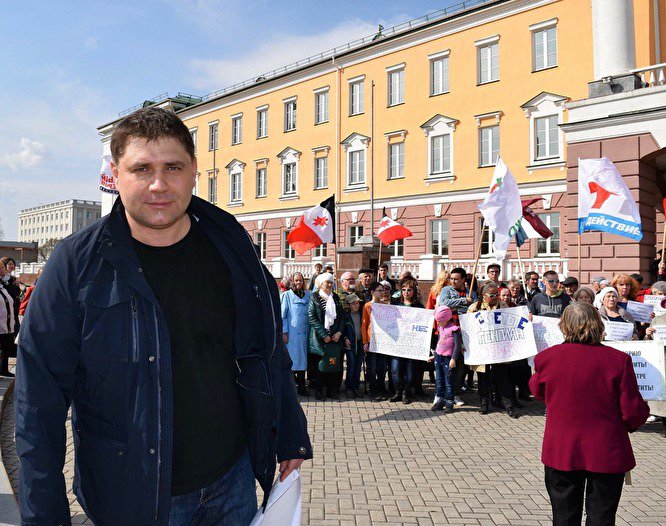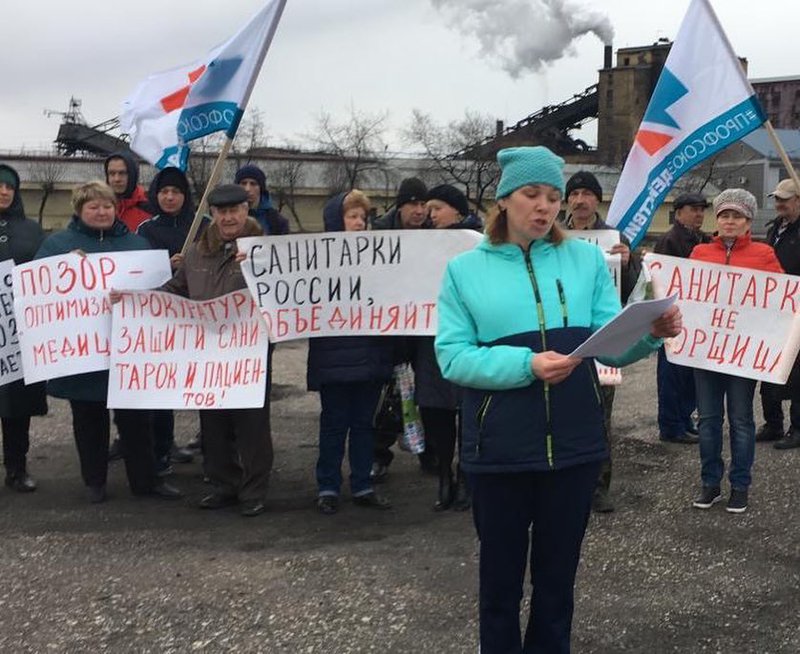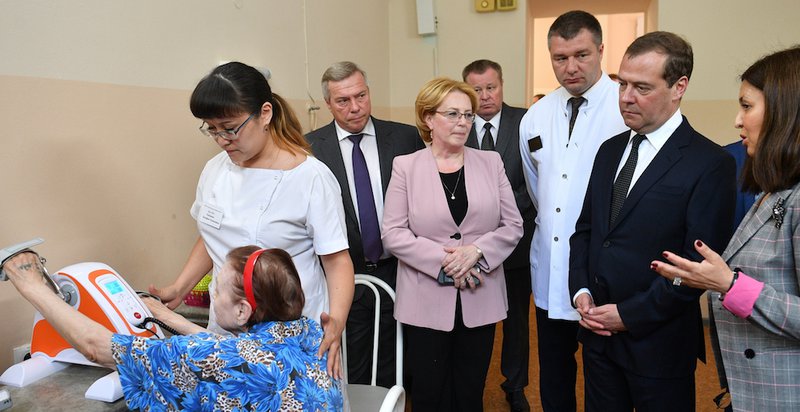What would happen if Russia’s healthcare system went on strike? Read this OpenDemocracy-Russia interview with healthcare union leader Andrey Konoval to find out.

Healthcare workers in Glazov, Udmurtiya, come out for better wages and conditions, June 2019 | Source: Andrey Konoval / Facebook.
Russia’s public healthcare system is facing significant problems, and staff are coming out as a result. Ambulance teams in Penza region, central Russia, recently called a work-to-rule action, bringing out more than 100 people in support of better wages and conditions, on the heels of a similar action by Novgorod region ambulance teams.
This wave of mobilisation is connected to serious overwork, staff cutbacks and shortages – which have arisen as part of the Russian government’s “May Decrees” initiative. These decrees, initially signed on the eve of Putin’s third inauguration in 2012 and recently updated, are designed to modernise Russia’s healthcare and education sectors, transferring financial responsibility to regional units while cutting back on federal grants. At the same time, these decrees linked pay rises for public sector personnel across the country to targets on pay and performance – which ended in significantly increasing workloads for healthcare staff. Naturally, this led to dissatisfaction.
Russia’s Action (Deistvie) trade union was founded in 2012 by healthcare workers from Moscow and Izhevsk, and a 2013 work-to-rule action in the latter brought its first success. Medics in the city organised a slowdown by performing their roles according to official guidelines, in order to show how their system was running on (excessive) overtime. Today, the union has 60 branches across 40 of Russia’s 85 regions, and is part of a growing independent trade union movement in the country.
Andrey Konoval is co-chairman of the Action union. With permission from leading Russian media Znak, we translate Evgeny Senshin’s recent interview with Andrey Konoval on official healthcare policy, the challenges facing healthcare workers in Russia, and why the country may be on the brink of an organising wave.

How would you define the Russian Ministry of Health’s policy today?
Despite fierce criticism from numerous experts, for many years the Ministry of Health has been defending the (pseudo-) insurance model of healthcare in Russia.
We’re talking first about maintaining the role of private insurance companies as a parasitic go-between between the Compulsory Health Insurance (OMS) fund and state healthcare institutions. These companies don’t take money from citizens, but for some reason they have the right to say where the money from regional health insurance schemes goes – and these funds come from the state and the compulsory health insurance fund. Meanwhile, it’s our opinion that the insurance companies don’t offer any real monitoring or control over the quality of healthcare. Instead, they take payments for “services” and fines from health centres, mostly as a result of mistakes in medical applications and documents.
This is doubly ridiculous. On the one hand, doctors have to deal with pointless paperwork, and on the other, healthcare centres – which are already dealing with a meagre grant situation – lose even more of their funds as a result.
“The current system of compulsory medical insurance is slowly but surely killing public sector healthcare”
The only reason, in my opinion, that the Ministry of Health is keeping this system is to continue commercialising healthcare in favour of private businesses. We’re not just talking about insurance providers, but private investors, including foreign ones.
First, the system of compulsory medical insurance gives private companies access to state funds. Minister Veronika Skvortsova has previously stated that she sees her goal as building a national system of healthcare under which state and private organisations have equal access to state funds.
Second, the current system of compulsory medical insurance is slowly but surely killing public sector healthcare, and dealing with a competitor is always useful. If there are queues in state healthcare institutions, if you need to wait several months for an examination, and then you’re offered the chance to do them for a fee, then naturally patients are forced to go private. Objectively speaking, Russia’s private medical sector wants patients to fall ill regularly, because that brings in profit. At the same time, the national healthcare system has an opposing aim – a healthy society that doesn’t fall ill too often. And here the system of preventative medicine is important, but it’s now more or less fallen apart.
This is why I’d say the following: the Ministry of Health’s policies contradict Article 41 of the Russian Constitution, which says that medical assistance in state and local institutions is given free to citizens. Russia needs to move to the state model of financing, which works well in many west European states.
That’s quite a general conclusion. What can you say about the Ministry of Health’s current work in terms of the existing model?
First, it needs to be said that the Ministry of Health’s functions have been cut back. In reality, the Ministry of Health doesn’t have real levers of control or management in the regions – in order to guarantee the normal financing of healthcare and that all norms and standards are observed. By this, I mean there is a lack of strong management provisions from the Ministry of Health. Tariffs for compulsory medical insurance are calculated at the regional level. And this often leads to underfinancing of the system by regional authorities when you compare it to the norms set at the federal level. This is why you have such a huge financing gap between different regions.
Meanwhile, the Ministry of Health and federal authorities hand down orders to optimise medical centres in order to fulfill the president’s “May Decrees”. This has led to a tragic situation for junior personnel in the healthcare system.

We’re talking here about porters and young nurses who have been reassigned as cleaners in order not to raise their wages according to the “May Decrees”. This leads to serious labour code violations and impacts the rate of medical assistance, to chaos in terms of who’s responsible for what, and to poor staff morale and high staff turnover.
Regulations over medical personnel’s work responsibilities have also been more or less destroyed. Now it’s the norm for a district doctor to serve two-to-three districts instead of two. Sometimes it’s even worse – a recent example involved a children’s clinic in Lyubertsy, Moscow. Over the course of several years, four-five pediatricians served the 12,000 children registered there. The usual standard is 800 children to a single district.
Our ambulance teams can do 20 call-outs per shift, and this is an extreme workload for staff. A permissible rate would be 11-13 call-outs per shift; for an emergency team – seven. Under this kind of workload, people can’t even have breaks to eat, go to the toilet. Meanwhile, in the regions, they’re creating unified dispatch services, which could send ambulance teams in one part of the region to the other end of it. As a result, perhaps there’ll be less call-outs, but staff will still spend all their time in the ambulances, without even stopping off at their dispatch centres. This all leads to over-exhaustion and stress, and in some cases, even death.
“The number of people with two jobs in Russia’s health system is shocking, without even talking about overtime on a normal shift”
A young anesthesiologist died at work recently, he’d been working in a hospital in Altai region. It’s said that doctors there work “two days on, one day off”. But a normal schedule, which would allow a doctor to rest fully, would be to work one day in every three. The local authorities said that an investigation showed that the schedule at this Altai hospital conformed to legislation. But if a lack of personnel and low wages mean that staff are taking time-and-a-half, double shifts or even more, then yes, formally, their work schedule is legal, but people have just had their normal work weeks taken away from them.
The number of people with two jobs in Russia’s health system is shocking, without even talking about overtime on a normal shift. Most guidance on work and medical assistance, including required numbers of personnel at a given institution, are recommendations. They are ignored.
What’s the situation with wages in state medicine today? According to recently published official figures, the hourly rate for medical and social care personnel has risen by 23% – to 259.8 roubles per hour, and 25% for monthly pay, to 40,000 roubles.
In terms of those average monthly wages published, these numbers are meaningless. Those statistics reflect the average wage for a single person, not a single job. It includes all the overtime that people work, when staff work over the number of permitted hours by taking another job on top of their first, or taking extra responsibilities while receiving the same wages.
As a result, these figures hide the double or triple overtime that people are having to work in reality.
As to the hourly rate, I have big doubts as to the veracity of those figures. At that rate, a monthly wage should definitely come to around 40,000 roubles per job, but even the majority of doctors in the regions don’t earn that much, without even talking about junior or mid-level staff.
Russia’s Accounts Chamber recently stated that the president’s “May Decrees” to raise wages for junior and mid-level staff have not been implemented in 50 out of 85 regions in the country. How has this situation come about? Is it sabotage in the regions or is the president making promises he can’t keep?
For a start, the “May Decrees” never had guaranteed financing. No one understood how much money there really was for their implementation.
I think the “May Decrees” were thought up in the political apparatus as a more substantive part of the strategy for developing the country. It’s even written there that the aim is to “preserve human resources in the public sector”. But the ministries that were responsible for implementing the decrees didn’t include objective information and then came up with some made-up indicators: by 2018, an average doctor’s wage should be 200% of the region’s average wage, and for junior and mid-level staff – 100% of the regional average.

As a result, we saw the huge problems with personnel only increase, because employers and officials turned out to have an interest in cutting the number of healthcare personnel while placing additional workloads on those who were left. And this was done in order to meet the indicators on high average wages for a single individual, rather than a single job.
It’s no surprise that ambulance workers in Penza region, where our union is campaigning for a wage increase, demanded that wages for mid-level staff (physician assistant, nurses and nurse anaesthetist) got 100% of the regional average wage per workload.
Before our union declared a work-to-rule strike in May, the wages in Penza were 16,000 roubles per workload. This is completely unreasonable money for such a difficult, emotionally and physically draining job. These are poverty wages that can’t support normal living standards for workers, not even talking about their families. As a result we’ve now got a 100% increase for those working in basic ambulance teams, plus an extra payment for emergency teams, but the negotiations are ongoing. Right now our working group’s aim is to get 100% of the regional average wage per workload, and this is written in the official strike report.
How much should medical personnel in the public sector receive, in your opinion?
Monthly wages in central Russia, that is without regional coefficients (such as in the north), should be at around 45,000-55,000 roubles for doctors, 28,000-38,000 roubles for mid-level personnel, and for junior – 20,000-28,000 roubles.
But I want to underline the fact that wages are low across the board in Russia. It’s not only medics who are underpaid, it’s everyone. Healthcare workers are particularly suffering from the state’s policies. This isn’t about the specifics of the healthcare profession or the fact that its physically difficult work, but that it’s highly qualified work that requires up to 10 years of training if we’re talking about doctors, as well as constant maintenance of those qualifications throughout your entire working life.
“We’re on the brink of a leap forward in organising, and this will help us take the defence of healthcare workers’ labour rights and public healthcare to a new level”
So far “work-to-rule” strikes have only been used in a few cities. Given the level of tension in society, could this turn into a mass protest?
The difficult situation facing medical personnel has come about as a result of mismanagement by Russia’s federal authorities, so this means that the solutions also lie at the national level.
I believe that we’re on the brink of a broad-based national campaign for changing state policy in the health sector. And this won’t only be the efforts of healthcare workers themselves, but an alliance with society, with patients and different civic organisations. Our trade union, at least, is preparing for this campaign. For example, we have a lot of ambulance personnel in our ranks, and so we created a section dedicated to emergency services inside the union. That section is now preparing a programme of national demands for ambulance workers.
But we’re also coming out for everyone – medical personnel, patients, citizens. I don’t believe it’s correct when there’s an attempt to use a broad protest campaign for someone’s narrow political project.
What kind of responsibility do medics have during a work-to-rule action? After all, someone could not receive medical assistance on time, and then their condition could worsen, and someone else could lose their life as a result.
When we’re preparing a work-to-rule action, we work through all the issues beforehand, including preventing negative consequences for patients. Given that a small number of workers are currently involved in work-to-rule actions, there’s no threat [of negative consequences].

